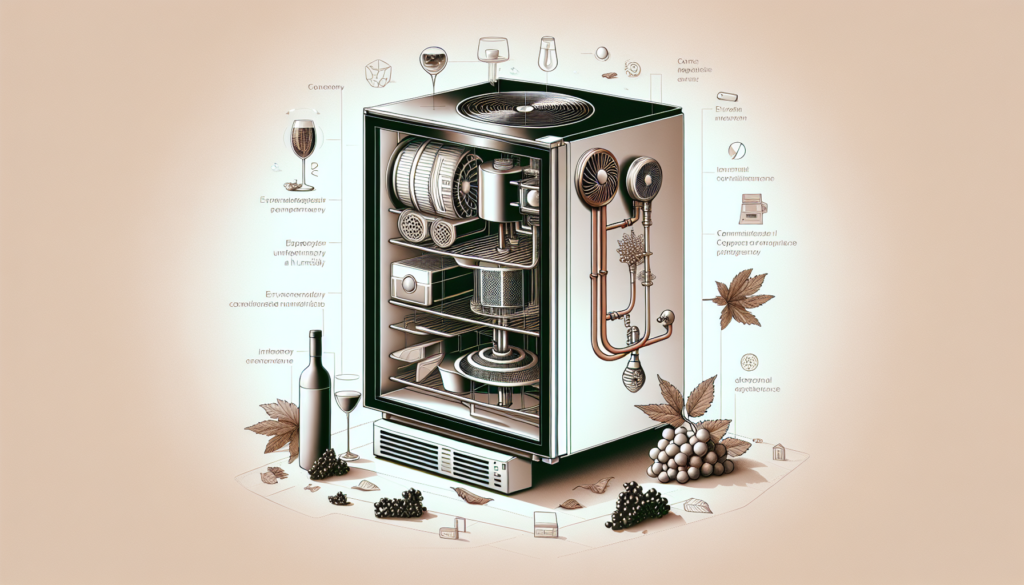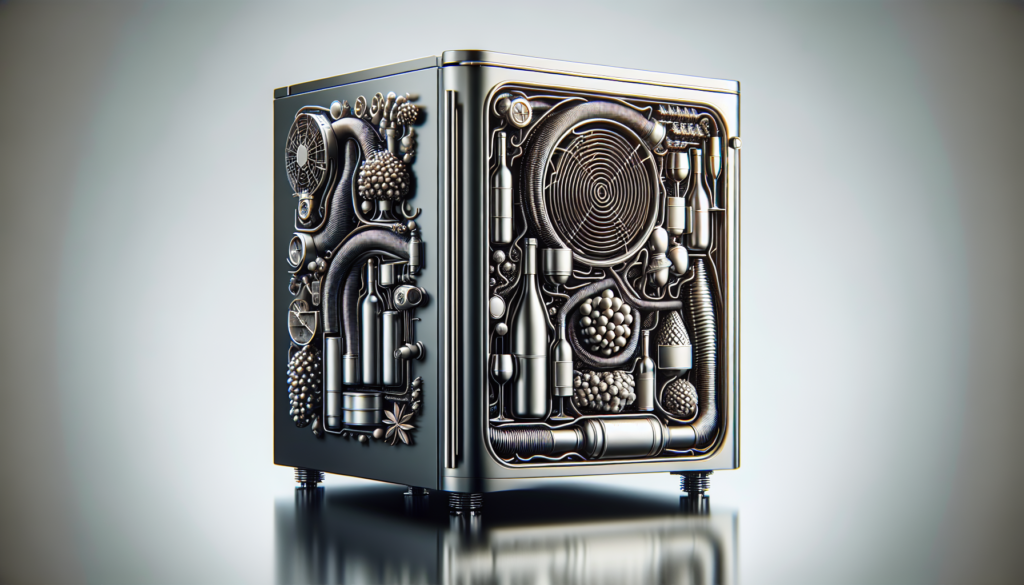Picture this: it’s a warm summer evening, and you’re hosting a casual dinner party at your place. As the laughter fills the air and the delicious aroma of food wafts from the kitchen, you reach for that perfectly chilled bottle of wine from your wine fridge. But have you ever wondered how that wine fridge keeps your favorite beverage at just the right temperature? Enter the wine fridge evaporator – a small but mighty component that works quietly behind the scenes to ensure your wine is always ready to be enjoyed. In this article, we’ll take a closer look at the wine fridge evaporator and discover the magic it brings to your wine drinking experience. So, let’s raise a glass and venture into the world of wine fridge evaporators together!
What is a Wine Fridge Evaporator?
Definition of a Wine Fridge Evaporator
A wine fridge evaporator is a crucial component of a wine refrigerator or wine cellar cooling system. It is responsible for maintaining the desired temperature and humidity levels inside the fridge, creating an ideal environment for storing and aging wines.
Function of a Wine Fridge Evaporator
The primary function of a wine fridge evaporator is to remove heat from the wine storage space, allowing the refrigeration cycle to cool the air inside. This process helps to maintain the optimal temperature and humidity for the wines, preserving their flavors and aromas.
Components of a Wine Fridge Evaporator
Cooling Coils
Cooling coils, also known as evaporator coils, are the main components of a wine fridge evaporator. These coils are made of copper or aluminum and are responsible for absorbing heat from the air inside the fridge.
Fan
The fan in a wine fridge evaporator helps to circulate the cooled air throughout the wine storage space. It ensures even distribution of the cool air, preventing any hot spots and maintaining a consistent temperature.
Expansion Valve
The expansion valve, also known as the throttle valve, is crucial in regulating the flow of refrigerant through the evaporator coils. It controls the pressure and temperature of the refrigerant, allowing it to evaporate and absorb heat.
Thermostat
The thermostat in a wine fridge evaporator is responsible for monitoring and maintaining the set temperature. It signals the compressor to cycle on and off as needed to adjust the cooling process.
Drainage System
The drainage system is an essential component of a wine fridge evaporator, as it collects the condensation that forms during the cooling process. It ensures that the excess moisture is properly drained away, preventing any leaks or damage to the unit.

How Does a Wine Fridge Evaporator Work?
Refrigeration Cycle
The wine fridge evaporator works based on the principles of the refrigeration cycle. The refrigerant, usually a gas or liquid, circulates through the cooling coils of the evaporator, absorbing the heat from the air inside. The warm refrigerant then travels to the compressor, where it is pressurized and converted into a high-pressure, high-temperature gas.
Evaporation Process
As the high-pressure gas enters the expansion valve, it rapidly expands, causing its pressure and temperature to decrease. This process transforms the gas into a cooler, low-pressure gas. The cool refrigerant then flows back into the evaporator coils, where it absorbs more heat from the wine storage space, starting the cycle again.
Heat Transfer
The wine fridge evaporator utilizes the process of heat transfer to cool down the air. By absorbing heat from the surrounding air and releasing it into the refrigerant, the evaporator helps create a cooler environment inside the wine fridge. This is essential for maintaining the optimal temperature and humidity levels required for wine storage.
Importance of a Wine Fridge Evaporator
Maintaining Optimal Temperature
One of the key reasons why a wine fridge evaporator is important is its role in maintaining the optimal temperature for wine storage. Wines are sensitive to temperature fluctuations, and too much heat or cold can negatively impact their flavors and aromas. The evaporator helps to regulate the temperature, ensuring that wines are stored at the ideal temperature range for preservation and aging.
Preservation and Aging of Wine
Proper wine storage is crucial for preserving and aging wines. The wine fridge evaporator plays a significant role in this process by providing a controlled environment with stable temperature and humidity levels. This helps wines to develop complex flavors and aromas over time, improving their overall quality.
Prevention of Mold and Condensation
The wine fridge evaporator also contributes to maintaining the right humidity level inside the wine storage space. Too much humidity can lead to mold growth, while too little can cause corks to dry out and wine to oxidize. The evaporator helps to regulate the humidity, preventing mold growth and minimizing the risk of condensation on the wine bottles.

Common Issues with Wine Fridge Evaporators
Frost Build-up
One common issue with wine fridge evaporators is the build-up of frost on the cooling coils. This can occur due to insufficient airflow or a malfunctioning defrost system. Frost build-up restricts the evaporator’s ability to absorb heat, leading to inadequate cooling and potential damage to the unit if not addressed.
Fan Malfunction
A malfunctioning fan can impede the proper circulation of cooled air inside the wine storage space. This can result in uneven temperature distribution and reduced cooling efficiency. A faulty or damaged fan should be repaired or replaced to ensure optimal performance of the wine fridge evaporator.
Clogged Drainage System
If the drainage system of a wine fridge evaporator becomes clogged, it can lead to water leaks and damage to the unit. Clogs may occur due to debris or mineral deposits accumulating in the drain line. Regular cleaning and maintenance can help prevent blockages and ensure proper functioning of the drainage system.
Preventive Maintenance for Wine Fridge Evaporators
Regular Cleaning and Defrosting
Regular cleaning of the wine fridge evaporator, especially the cooling coils, is essential to prevent frost build-up and maintain efficient cooling. Additionally, defrosting the unit periodically helps remove any accumulated ice or frost, ensuring optimal performance.
Checking Fan Operation
Regularly checking the fan operation is crucial to ensure proper airflow and distribution of cooled air. Make sure the fan is running smoothly and that there are no obstructions affecting its performance. Clean or replace the fan if necessary.
Clearing Drainage System
To prevent clogs and water leaks, it is important to clear the drainage system of the wine fridge evaporator regularly. Remove any debris or mineral deposits from the drain line and ensure that water can flow freely out of the unit.
How to Troubleshoot Wine Fridge Evaporator Problems
Identifying Frost Build-up
If you notice frost build-up on the cooling coils of your wine fridge evaporator, it indicates a problem. Insufficient cooling and temperature fluctuation can be signs of frost accumulation. Check for any obstructions blocking the airflow and ensure that the defrost system is functioning properly.
Ensuring Proper Airflow
If you notice uneven temperature distribution or inadequate cooling, the airflow within the wine storage space may be restricted. Make sure that there are no obstructions blocking the airflow, such as bottles placed too closely together or other items obstructing the vents.
Checking Thermostat Settings
If the temperature inside the wine storage space is not within the desired range, check the thermostat settings. Ensure that the thermostat is properly calibrated and set to the desired temperature. If necessary, recalibrate or replace the thermostat to maintain accurate temperature control.
Repairing Wine Fridge Evaporator Issues
Replacing Faulty Cooling Coils
If the cooling coils of your wine fridge evaporator are damaged or ineffective, they may need to be replaced. Faulty coils can impair the cooling capacity of the unit and lead to inconsistent temperatures. Consult a professional technician to safely replace the cooling coils.
Repairing or Replacing the Fan
A malfunctioning fan can significantly impact the performance of a wine fridge evaporator. If the fan is not operating correctly or has stopped working altogether, it may need to be repaired or replaced. Contact a qualified technician to handle the repair or replacement of the fan.
Unclogging the Drainage System
If you experience water leaks or notice that the drainage system is blocked, it is necessary to unclog it. Clear any debris or mineral deposits from the drain line to ensure proper drainage and prevent damage to the wine fridge evaporator. If the clog persists, seek professional assistance.
Choosing the Right Wine Fridge Evaporator
Considerations for Wine Storage
When selecting a wine fridge evaporator, consider the specific requirements of your wine storage needs. Factors to consider include the number of bottles to be stored, the desired temperature and humidity range, and the available space for the unit.
Sizing and Placement
Ensure that the wine fridge evaporator you choose is appropriately sized for your wine storage space. Consider the dimensions of the unit and how it will fit within your existing wine refrigerator or cellar. Proper placement is crucial for efficient cooling and airflow.
Energy Efficiency
Energy efficiency is an important factor to consider when choosing a wine fridge evaporator. Look for units with high energy efficiency ratings to minimize power consumption and reduce your carbon footprint. Additionally, energy-efficient units tend to operate more quietly and produce less heat, which can be beneficial for long-term wine storage.
Maintaining the Wine Fridge Evaporator’s Performance
Regular Check-ups and Servicing
To ensure the optimal performance of your wine fridge evaporator, schedule regular check-ups and servicing with a qualified technician. They can inspect the unit, clean the components, and address any potential issues before they escalate.
Monitoring Temperature and Humidity
Monitor the temperature and humidity levels inside your wine storage space regularly. Use a reliable thermometer and hygrometer to ensure that the conditions remain within the ideal range for wine storage. Adjust the settings of the wine fridge evaporator if necessary.
Organizing and Storing Wine Properly
Proper organization and storage of wine bottles are essential for maintaining the performance of the wine fridge evaporator. Store bottles in a way that allows for proper airflow and prevents any obstructions to the cooling process. Avoid overcrowding and ensure efficient circulation of cooled air.
In conclusion, a wine fridge evaporator is a vital component in creating an ideal storage environment for wines. Understanding its function, components, and operation can help ensure the proper maintenance and performance of your wine refrigerator or cellar. By following preventive maintenance measures and addressing any issues promptly, you can continue to enjoy perfectly stored and aged wines for years to come.
